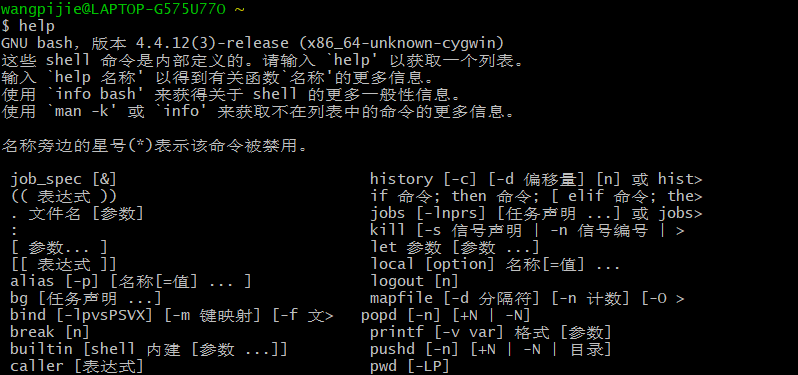OS第1次实验报告:熟悉使用Linux命令和剖析ps命令
2020-03-05 20:38 Wangpj 阅读(171) 评论(0) 收藏 举报姓名:王丕杰
学号:201821121052
班级:计算1812
1.实验环境介绍
操作系统:Window10(版本:18363.657)
平台:Cygwin
用户名:wangpijie

2. 常用命令使用
举例如下:

3. 剖析ps命令
(1)ps使用方法及参数
SYNOPSIS
ps [−aA] [−defl] [−g grouplist] [−G grouplist]
[−n namelist] [−o format]... [−p proclist] [−t termlist]
[−u userlist] [−U userlist]
−a Write information for all processes associated with termi‐ nals. Implementations may omit session leaders from this list. −A Write information for all processes. −d Write information for all processes, except session leaders. −e Write information for all processes. (Equivalent to −A.) −f Generate a full listing. (See the STDOUT section for the contents of a full listing.) −g grouplist Write information for processes whose session leaders are given in grouplist. The application shall ensure that the grouplist is a single argument in the form of a <blank> or <comma>-separated list. −G grouplist Write information for processes whose real group ID numbers are given in grouplist. The application shall ensure that the grouplist is a single argument in the form of a <blank> or <comma>-separated list. −l Generate a long listing. (See STDOUT for the contents of a long listing.) −n namelist Specify the name of an alternative system namelist file in place of the default. The name of the default file and the format of a namelist file are unspecified. −o format Write information according to the format specification given in format. This is fully described in the STDOUT section. Multiple −o options can be specified; the format specifica‐ tion shall be interpreted as the <space>-separated concate‐ nation of all the format option-arguments. −p proclist Write information for processes whose process ID numbers are given in proclist. The application shall ensure that the proclist is a single argument in the form of a <blank> or <comma>-separated list. −t termlist Write information for processes associated with terminals given in termlist. The application shall ensure that the termlist is a single argument in the form of a <blank> or <comma>-separated list. Terminal identifiers shall be given in an implementation-defined format. On XSI-conformant sys‐ tems, they shall be given in one of two forms: the device's filename (for example, tty04) or, if the device's filename starts with tty, just the identifier following the characters tty (for example, "04"). −u userlist Write information for processes whose user ID numbers or lo‐ gin names are given in userlist. The application shall en‐ sure that the userlist is a single argument in the form of a <blank> or <comma>-separated list. In the listing, the nu‐ merical user ID shall be written unless the −f option is used, in which case the login name shall be written. −U userlist Write information for processes whose real user ID numbers or login names are given in userlist. The application shall ensure that the userlist is a single argument in the form of a <blank> or <comma>-separated list. With the exception of −f, −l, −n namelist, and −o format, all of the options shown are used to select processes. If any are specified, the default list shall be ignored and ps shall select the processes repre‐ sented by the inclusive OR of all the selection-criteria options.
(2)运行并解释ps命令参数
①运行ps命令,结果如下:
$ ps PID PPID PGID WINPID TTY UID STIME COMMAND 1451 1450 1451 8932 pty0 197609 19:58:09 /usr/bin/bash 1473 1451 1473 12360 pty0 197609 20:13:59 /usr/bin/ps 1450 1 1450 11656 ? 197609 19:58:07 /usr/bin/mintty
②运行ps -ef 命令,结果如下:
$ ps -ef UID PID PPID TTY STIME COMMAND wangpiji 1474 1451 pty0 20:15:18 /usr/bin/ps wangpiji 1451 1450 pty0 19:58:09 /usr/bin/bash wangpiji 1450 1 ? 19:58:07 /usr/bin/mintty
参数含义:
e :表示显示全部进程
f :表示完整-格式,包括命令行
③运行ps aux 命令,结果如下:
$ ps aux PID PPID PGID WINPID TTY UID STIME COMMAND 1451 1450 1451 8932 pty0 197609 19:58:09 /usr/bin/bash 1450 1 1450 11656 ? 197609 19:58:07 /usr/bin/mintty 1475 1451 1475 19468 pty0 197609 20:16:54 /usr/bin/ps
参数含义:
a :显示现行终端机下的所有程序,包括其他用户的程序
u :以用户为主的格式来显示程序状况
x : 显示所有程序,不以终端机来区分
(3)字段含义
UID:用户ID
PID:进程ID
PPID:父进程ID
PGID:进程组ID
TTY:终端的次要装置号码
STIME:进程开始时间
COMMAND:所执行的指令


 浙公网安备 33010602011771号
浙公网安备 33010602011771号